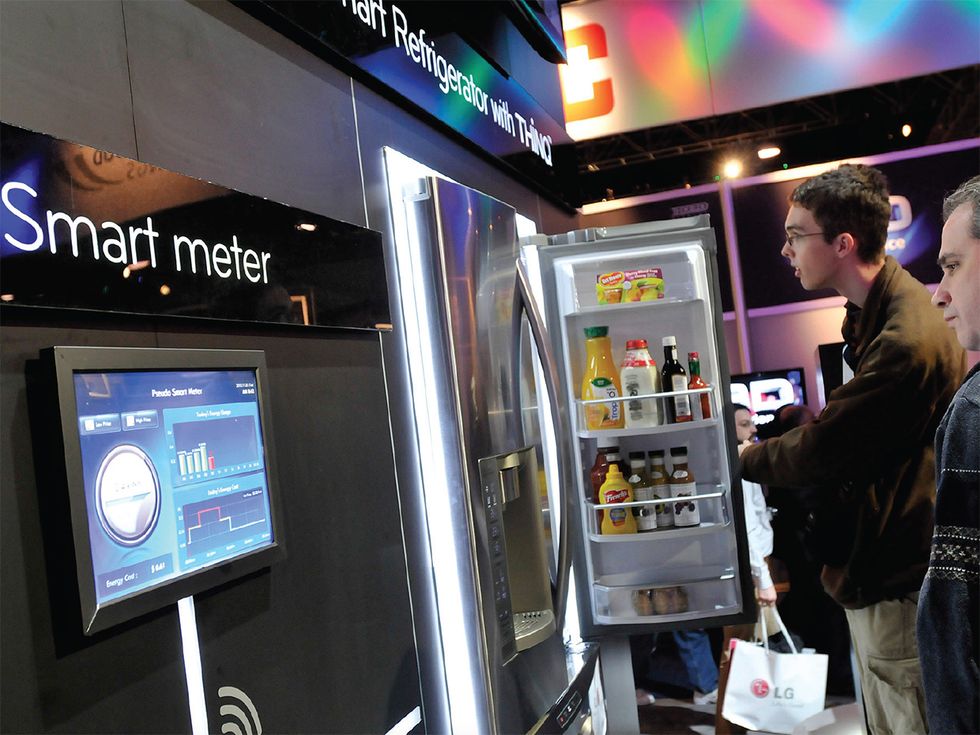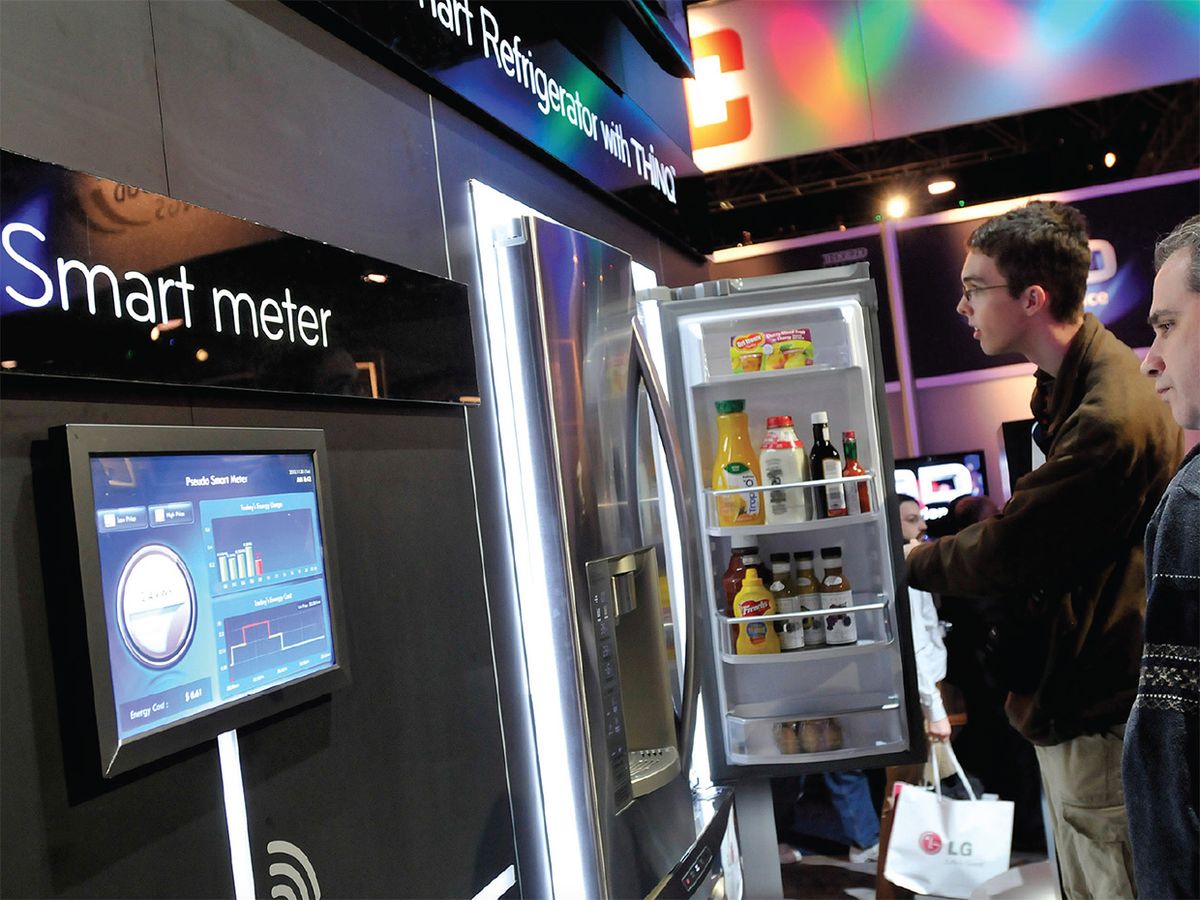
If your electric company tells you to cut back your energy use or face the possibility of a blackout, you’ll probably comply. You’ll turn off unnecessary lights and appliances and use the air conditioner less. But the moment the crisis is averted, you’ll quickly return to your old habits. That’s because in spite of what people say about wanting to protect the environment and save money, they rarely limit their energy consumption to achieve these goals. Convenience always trumps conservation.

At one time, managers at electric utilities thought they could change consumer behavior by making electricity more expensive at certain times of day. That hasn’t worked. The price premium needed to spur conservation seems to be higher than utilities will—or can—charge. That’s the bad news. But there’s also good news: Although price hikes may not work, clever tricks, it seems, will.
First, let’s talk about the problem.
These days, it’s not really about efficiency. Energy-efficient appliances have helped reduce overall electricity demand, but a big problem remains. Most people still get out of bed, leave for work, and return home at roughly the same time of day. And—no surprise—their schedules dictate their energy use, which tends to peak in the late afternoon on weekdays, from 3 to 6 p.m. or so, when offices are still open but people are also arriving home from work, turning on air conditioners, TVs, and ovens. The resulting surge in demand can double the amount of energy flowing through the power grid in a matter of minutes.
That surge means that power utilities have to keep an enormous amount of generating capacity in reserve. That’s why they need “peaker plants.” This extra generating capacity is expensive to build and maintain, so these plants are often old and inefficient ones that utilities would have otherwise shut down years ago. Peaker plants therefore cost a lot more to run than the utility’s usual generating plants—as much as triple the cost. Consumers may not realize it, but they can basically blame peaker plants when they complain about high rates. And old plants are not necessarily the most environmentally friendly, either.
So consumers’ pocketbooks and the environment would both benefit from leveling out people’s electricity use. It should be easy: Two-thirds of residential electricity use in the United States (but somewhat less in Europe) comes from air conditioners, refrigerators, washers, dryers, and other electric appliances. People—or even better, automated controls—can adjust thermostats during the day and run washers and dryers in the middle of the night. Even small reductions in air conditioner use and delays in when appliances get switched on can help control the peaks in energy demand and reduce accompanying costs.
Utilities have for years dangled financial incentives in front of consumers to try to get them to trim or defer usage during peak hours. But taking advantage of those incentives requires awareness and active planning on the part of harried consumers. And that’s just not happening. What’s needed is automation that makes conservation simple, clever tricks to fool users into saving energy, and, perhaps, more impressive financial incentives, though it’s clear that tricks and automation alone would go a long way.
Some residential consumers already let utilities shut off their air-conditioning systems when needed, in return for a credit on their bills. In California, for example, the Pacific Gas & Electric Company (PG&E) offers several such arrangements. The SmartAC program, with more than 100 000 participants, places a remote-controlled device on each home’s air conditioner, allowing PG&E to reduce usage during peak summer hours. It cycles the A/C through 15 minutes of normal operation, then 15 minutes on blower only. Consumers receive a reward check—a pittance really, enough perhaps to buy one or two lattes a month.
In Canada about a year ago, the Ontario Energy Board made a well-publicized move to time-of-use pricing, with almost a two-to-one difference between peak and off-peak rates. Many other utilities offer such inducements to try to get consumers to shift their consumption away from peak hours. But these efforts have done little to alter usage patterns. Anthony Haines, Toronto Hydro Electric System’s chief executive, believes that the savings are simply too modest. He thinks that peak electricity would have to cost 10 times as much as off-peak energy before utilities would move even 5 percent of their customers in the right direction.
In 2008, researchers from Xerox’s Palo Alto Research Center went into homes in Northern California in an attempt to gauge the extent that money mattered to power consumers. Three investigators spent four months on this study, surveying 646 people. They reviewed energy bills, metered appliances, logged daily usage, and conducted interviews in 20 households.

Basically, the study sought to quantify how much ordinary people would tolerate the inconvenience of avoiding, delaying, or reducing power consumption of various home appliances in response to higher electricity prices during certain times of day. The researchers put placards on people’s appliances showing what it cost to use that appliance at various times. Electricity rates were cheapest early in the morning and overnight and most expensive in the afternoon and early evening. Participants then logged their usage.
To the researchers’ surprise, most of the study participants showed no inclination to save money by modifying their choices of when to use energy. For the most part, it seems, Californians don’t care at all about the cost of electricity.
Clearly, the current financial incentives are too small to motivate meaningful conservation. This is particularly true for devices that draw a relatively small amount of power—a laptop, for example. Indeed, in talking with these researchers, some study participants learned that computers were even cheaper to run than they had thought. And so they concluded that computers were not worth turning off to save energy. As one of the participants put it, “You’re going to eat when you want to eat. You’re going to watch TV when you want to watch TV. You know?” Strangely, several participants mentioned that they would turn off refrigerators or computers if they made too much noise. Some also said they avoided using their ovens when the weather was hot. So while people were clearly willing to cut back on power usage to avoid minor discomfort, they were not inclined to do so for the purpose of saving money or conserving energy.
Several study participants did say they intended to reduce their energy consumption and briefly tried to do so. But the inconvenience or discomfort of coming home to a cold house, for example, or waiting for a computer to boot up typically outweighed any desire for cost savings, and they quickly fell back into their old habits.
The investigators who conducted this study noted that the user interfaces of the home appliances encouraged wastefulness, seemingly by design. For example, the default settings on clothes washers, dryers, and dishwashers aren’t the most energy efficient. And while most appliances offer more-efficient cycles, users typically stick to default settings if they work well enough. The choice quickly becomes locked into a habit that lasts for the lifetime of the appliance. Users aren’t likely to do comparison testing and will rarely bother to find out if a mode that uses less power (using cold water, perhaps, or a shorter cycle time on a clothes washer) does the job as well as the default setting.
This tendency to go with factory settings can, however, have an upside. Designers could simply tweak the user interfaces on appliances to make the energy-saving mode the default—in a sense tricking the user into conserving. Manufacturers could easily relabel dials so that the “normal” option would be the most efficient. If it’s more trouble to hit a button for the high-energy cycle, the typical consumer is unlikely to do it.
Although reducing the amount of electricity that appliances draw in this way may be helpful, it won’t go far enough. Far more of afternoon peak usage comes from HVAC (heating, ventilation, and air-conditioning) units; ovens, microwaves, and other cookers; and televisions. HVAC systems alone make up over 30 percent of a typical home’s energy use, according to the U.S. Department of Energy. And televisions account for more than 10 percent of residential energy demand in the United States.

The low-hanging fruit here are thermostat settings, which could be raised or lowered slightly for short periods of time, in response to real-time pricing or the use of other appliances in the home; temperatures might vary a little more than they do with a constant temperature setting but would remain comfortable.
But you can’t expect consumers to manage such fine-grained control. After all, who wants to be constantly tweaking thermostats after a tiring day? More advanced, automated controls are clearly needed. And they are coming. In the next few years, new technologies are going to begin making their way into households, and some of these will dramatically change the domestic-energy picture.
These automated control systems will be connected to the Internet, of course, so they can follow moment-by-moment changes in the cost of electricity. But these systems won’t just respond slavishly to real-time pricing data. They will also track what the people in the house are doing or figure out what they might want to do based on their habits. A system that turns off the TV when someone is engrossed in his favorite show is only going to do that once before the user disables it. These new smart-grid systems will have to be, well, smart.
Such technology is just now starting to hit the market. Toronto Hydro Corp.’s Peaksaver program, for example, attaches a smart switch to a home air conditioner that turns it on and off in response to the daily fluctuations in electricity demand. The off times are short, perhaps only 10 or 20 minutes, so the temperature of the home changes little.
Managing the electricity consumed outside of the HVAC system is, however, more complex. Other devices consume far less power individually (clothes washers, clothes dryers, and electric ovens) or have only one power setting when in use (TVs, desktop computers, radios, and speaker systems), or allow only minor adjustments (dishwashers and lighting). To have an impact, multiple appliances must be turned off, turned down, or delayed, at least temporarily. And that’s the problem: The large family of appliances in a home represents a very unwieldy ensemble for a consumer to manage.
The solution will have to be far more sophisticated than anything we see on the market today. In these future systems, all these appliances would connect to a device that we call a domestic energy marketplace server. Such a server could turn appliances on and off, having them cooperate with one another to manage the household’s overall energy use. Take the dishwasher. Right now, most dishwashers have a delay option: You can load your dishwasher now and set it to run, say, in an hour. So a particularly conscientious consumer could—though most people won’t—set the dishwasher to run after 8 p.m., when air conditioning use would likely diminish. This would help moderate energy demand a little, although not that much.
Here’s a better idea. Suppose that dishwasher is integrated with a home’s energy marketplace server. The server’s software tracks rates and pricing trends, so the system understands that in the summer, the optimum time to run a dishwasher is likely after 8 or 9 p.m. So far, that’s not a lot different from an ordinary delay switch, though the delay will be adjusted automatically, rather than by the user.
But say a power plant goes off-line somewhere on the local grid, causing prices to spike. Instead of starting that dishwasher at 8 p.m. as usual, your home energy server communicates with the utility and determines that there would be a considerable cost savings by delaying energy use, at which point it changes the start time. If the dishwasher had already started when the emergency occurred, the server would know whether the dishwasher could be reasonably interrupted. For example, it would stop the dishwasher if it was just heating water, but if it was in the midst of dispensing detergent, it would wait until after the next rinse cycle. Now add an electric oven to the mix. Again, the server would understand when that appliance could be shut down (during self-cleaning, say) and when it can’t (while cooking dinner).
If each home in a neighborhood had such equipment in place, the energy marketplace servers in these homes could communicate among themselves to reduce demand within an entire neighborhood in response to pricing signals from the power provider. Having a whole neighborhood cooperate could mean big cost savings for individual homeowners because the neighborhood could work collectively—and still automatically—with the power provider to save energy in response to price incentives.
For the utility, this would not only reduce the costs of power generation, it would also reduce the cost of power distribution. That’s because the midvoltage feed lines going into a neighborhood are sized to serve the worst case. All of those homes have air conditioners that cycle on and off at random times. It’s possible, in that situation, that most of those air conditioners might coincidentally turn on at the same time, so the utility has to make sure that the lines and transformers that go into the neighborhood can handle that theoretical peak demand. But if energy marketplace servers in homes cooperated to coordinate the on-off cycling of air conditioners, those theoretical peaks—when every air conditioner turns on at the same time—just wouldn’t happen, and the utility could build a distribution system for a much lower peak load.
Initially, an energy marketplace server would work directly with utilities, adjusting to the utilities’ time-of-use pricing schedules. In the future, though, these servers could save homeowners a lot more money by working with an energy aggregator. An energy aggregator would sign up people who agreed to reduce their energy use on demand at negotiated prices, and then pay consumers for that reduction. Then the aggregator could turn around and sell this demand reduction to a utility at essentially the same price it would cost the utility to buy the equivalent amount of energy on the spot market. Customers would likely make more through this type of spot-market negotiation than they would through standard time-of-use pricing, and aggregators could profit by setting a small differential between the price they charge the utility and the price they pay the customer.
We’re not there yet, however. In the meantime, you’ll likely see home energy-use controllers that are less sophisticated. But they’ll be smart enough to run appliances on a cost-efficient schedule, given the household’s electric rate plan, while taking into account user preferences. Some people really like getting their dishes done in time to empty the machine before bed, for example, whereas others don’t care.
Several companies have taken the first steps at creating computerized energy dashboards with some limited appliance control. Such controllers adjust temperatures, lighting, and appliance settings based on predicted usage or user input. Some can also display the expected cost of running an appliance at a given time, so customers can choose an optimal schedule. This technology could encourage consumers to develop energy-saving habits.
For example, Intel has developed (but is not yet marketing) a home energy management system. And Control4, a home-automation company based in Salt Lake City, has an energy dashboard already on the market, the EC-100. Earlier this year, California’s PG&E began distributing these dashboards to a test group of customers.
Further in the future, systems that get to know you could make adjustments you don’t even notice, by monitoring your behavior and learning from it. For example, a domestic power-management system could use video, audio, and other types of sensors to detect what you’re doing. By tracking your patterns, it could eventually learn to predict when certain savings may be acceptable. For instance, the system could learn to postpone doing laundry that’s never retrieved from the washer until the morning anyway, to turn off heating and lighting in empty rooms that tend to stay unoccupied for long periods once exited, to turn TVs and music players on and off in different rooms as you move around, even to turn down lights when the TV is on and turn off the TV when you fall asleep watching the late show.
And we’d be saving energy without even knowing it—the best way of all.
About the Authors
Marc Mosko and Victoria Bellotti, are researchers at Xerox’s Palo Alto Research Center (PARC). Mosko focuses on wireless data network access and routing; Bellotti helps clients build technology businesses around the world. When they’re not at PARC, Bellotti moonlights as a jazz vocalist around the Bay Area, while Mosko continues his battle with local authorities to install a natural gas compressor in his 1890s home to fuel his CNG car.
To Probe Further
For more on energy conservation and consumer behavior, see “Home, Habits, and Energy: Examining Domestic Interactions and Energy Consumption,” by James Pierce, Diane J. Schiano, and Eric Paulos, Proceedings of the 28th International Conference on Human Factors in Computing Systems (April 2010).
